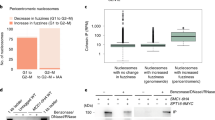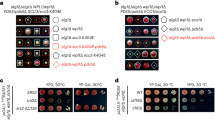Abstract
Heterochromatin performs a central role in chromosome segregation and stability by promoting cohesion at centromeres1,2. Establishment of both heterochromatin-mediated silencing and cohesion requires passage through S phase, although the mechanism is unknown3,4. Here we demonstrate that Schizosaccharomyces pombe Hsk1 (CDC7), a conserved Dbf4-dependent protein kinase (DDK) that regulates replication initiation5, interacts with and phosphorylates the heterochromatin protein 1 (HP1) equivalent Swi6 (ref. 6). Hsk1 and its regulatory subunit Dfp1 function downstream of Swi6 localization to promote heterochromatin function and cohesion specifically at centromeres. This role for Hsk1–Dfp1 is separable from its replication initiation activity, providing a temporal link between S phase and centromere cohesion that is mediated by heterochromatin.
This is a preview of subscription content, access via your institution
Access options
Subscribe to this journal
Receive 12 print issues and online access
$209.00 per year
only $17.42 per issue
Buy this article
- Purchase on Springer Link
- Instant access to full article PDF
Prices may be subject to local taxes which are calculated during checkout




Similar content being viewed by others
References
Bernard, P. et al. Requirement of heterochromatin for cohesion at centromeres. Science 294, 2539–2542 (2001).
Nonaka, N. et al. Recruitment of cohesin to heterochromatic regions by Swi6/HP1 in fission yeast. Nature Cell Biol. 4, 89–93 (2002).
Uhlmann, F. & Nasmyth, K. Cohesion between sister chromatids must be established during DNA replication. Curr. Biol. 8, 1095–1101 (1998).
Rusche, L.N., Kirchmaier, A.L. & Rine, J. The establishment, inheritance and function of silenced chromatin in Saccharomyces cerevisiae. Annu. Rev. Biochem. 481–516 (2003).
Masai, H. & Arai, K. Cdc7 kinase complex: a key regulator in the initiation of DNA replication. J. Cell Physiol. 190, 287–296 (2002).
Ekwall, K. et al. The chromodomain protein Swi6 — a key component at fission yeast centromeres. Science 269, 1429–1431 (1995).
Nasmyth, K. Disseminating the genome: joining, resolving, and separating sister chromatids during mitosis and meiosis. Annu. Rev. Genet. 35, 673–745 (2001).
Snaith, H.A., Brown, G. & Forsburg, S.L. S. pombe Hsk1p is a potential Cds1p target required for genome integrity. Mol. Cell. Biol. 20, 7922–7932 (2000).
Takeda, T. et al. Regulation of initiation of S phase, replication checkpoint signaling, and maintenance of mitotic chromosome structures during S phase by Hsk1 kinase in the fission yeast. Mol. Biol. Cell 12, 1257–1274. (2001).
Fung, A.D., Ou, J., Bueler, S. & Brown, G.W. A conserved domain of Schizosaccharomyces pombe dfp+ is uniquely required for chromosome stability following alkylation damage during S phase. Mol. Biol. Cell 22, 4477–4490 (2002).
Smothers, J.F. & Henikoff, S. The HP1 chromo shadow domain binds a consensus peptide pentamer. Curr. Biol. 10, 27–30 (2000).
Murzina, N., Verreault, A., Laue, E. & Stillman, B. Heterochromatin dynamics in mouse cells: interaction between chromatin assembly factor 1 and HP1 proteins. Mol. Cell 4, 529–540 (1999).
Zhao, T., Heyduk, T. & Eissenberg, J.C. Phosphorylation site mutations in heterochromatin protein 1 (HP1) reduce or eliminate silencing activity. J. Biol. Chem. 276, 9512–9518 (2001).
Brown, G.W. & Kelly, T.J. Purification of Hsk1, a minichromosome maintenance protein kinase from fission yeast. J. Biol. Chem. 273, 22083–22090 (1998).
Tomonaga, T. et al. Characterization of fission yeast cohesin: essential anaphase proteolysis of Rad21 phophorylated in the S phase. Genes Dev. 14, 2757–2770 (2000).
Pidoux, A.L., Uzawa, S., Perry, P.E., Cande, W.Z. & Allshire, R.C. Live analysis of lagging chromosomes during anaphase and their effect on spindle elongation rate in fission yeast. J. Cell Sci. 113, 4177–4191 (2000).
Brown, G.W. & Kelly, T.J. Cell cycle regulation of Dfp1, an activator of the Hsk1 protein kinase. Proc. Natl Acad. Sci. USA 96, 8443–8448 (1999).
Takeda, T. et al. A fission yeast gene, him1(+)/dfp1(+), encoding a regulatory subunit for Hsk1 kinase, plays essential roles in S-phase initiation as well as in S-phase checkpoint control and recovery from DNA damage. Mol. Cell. Biol. 19, 5535–5547 (1999).
Bernard, P., Hardwick, K. & Javerzat, J.-P. Fission yeast Bub1 is a mitotic centromere protein essential for the spindle checkpoint and the preservation of correct ploidy through mitosis. J. Cell Biol. 143, 1775–1787 (1998).
Grewal, S.I. & Klar, A.J. Chromosomal inheritance of epigenetic states in fission yeast during mitosis and meiosis. Cell 86, 95–101 (1996).
Ekwall, K. et al. Mutations in the fission yeast silencing factors Clr4+ and Rik1+ disrupt the localisation of the chromo domain protein Swi6p and impair centromere function. J. Cell Sci. 109, 2637–2648 (1996).
Ekwall, K., Olsson, T., Turner, B.M., Cranston, G. & Allshire, R.C. Transient inhibition of histone deacetylation alters the structural and functional imprint at fission yeast centromeres. Cell 91, 1021–1032 (1997).
Allshire, R.C., Javerzat, J.P., Redhead, N.J. & Cranston, G. Position effect variegation at fission yeast centromeres. Cell 76, 157–169 (1994).
Allshire, R.C., Nimmo, E.R., Ekwall, K., Javerzat, J.P. & Cranston, G. Mutations derepressing silent centromeric domains in fission yeast disrupt chromosome segregation. Genes Dev. 15, 218–233 (1995).
Bahler, J. et al. Heterologous modules for efficient and versatile PCR-based gene targeting in Schizosaccharomyces pombe. Yeast 14, 943–951 (1998).
Moreno, S., Klar, A. & Nurse, P. Molecular genetic analysis of the fission yeast Schizosaccharomyces pombe. Methods Enzymol. 194, 795–823 (1991).
Ekwall, K., Cranston, G. & Allshire, R.C. Fission yeast mutants that alleviate transcriptional silencing in centromeric flanking repeats and disrupt chromosome segregation. Genetics 153, 1153–1169 (1999).
Partridge, J.F., Borgstrom, B. & Allshire, R.C. Distinct protein interaction domains and protein spreading in a complex centromere. Genes Dev. 14, 783–791 (2000).
Edwards, R.J. & Carr, A.M. Analysis of radiation-sensitive mutants of fission yeast. Methods Enzymol. 283, 471–493 (1997).
Nabeshima, K. et al. Dynamics of centromeres during metaphase–anaphase transition in fission yeast: Dis1 is implicated in force balance in metaphase bipolar spindle. Mol. Biol. Cell 9, 3211–3225 (1998).
Acknowledgements
We are especially grateful to G.W. Brown for communicating results before publication, for providing dfp1 strains and for the Hsk1 kinase assay protocol. We thank H.-K. Huang for the Rad21 plasmid, J.-P. Javerzat for cosmids, and J. Partridge for RT-PCR protocols. We thank our colleagues in the Molecular and Cell Biology Laboratory for discussion and comments on the manuscript. J.M.B. was supported by the Damon Runyon Cancer Research Foundation, fellowship DRG-1634. P.B. was funded by a Wellcome Trust Travelling Research Fellowship, l′ Association pour la Recherche sur le Cancer, la Ligue Nationale Contre le Cancer and the Centre National de la Recherche Scientifique. R.C.A. is a Wellcome Trust Principal Research Fellow funded by EC RTN Contract: ERBFMRXCT980212 and core funding from the Medical Research Council, UK. This work was supported by American Cancer Society grant RSG-00-132-04-CCG and a Stohlman Scholarship from the Leukemia and Lymphoma Society to S.L.F.
Author information
Authors and Affiliations
Corresponding author
Supplementary information
Rights and permissions
About this article
Cite this article
Bailis, J., Bernard, P., Antonelli, R. et al. Hsk1–Dfp1 is required for heterochromatin-mediated cohesion at centromeres. Nat Cell Biol 5, 1111–1116 (2003). https://doi.org/10.1038/ncb1069
Received:
Accepted:
Published:
Issue Date:
DOI: https://doi.org/10.1038/ncb1069
This article is cited by
-
Cdc7 kinase stimulates Aurora B kinase in M-phase
Scientific Reports (2019)
-
New insights into cohesin loading
Current Genetics (2018)
-
Structure of centromere chromatin: from nucleosome to chromosomal architecture
Chromosoma (2017)
-
Dynamic phosphorylation of HP1α regulates mitotic progression in human cells
Nature Communications (2014)
-
Three wise centromere functions: see no error, hear no break, speak no delay
EMBO reports (2013)



